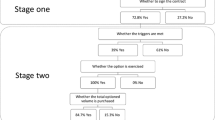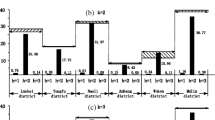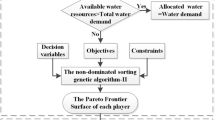Abstract
Water Saving Management Contract (WSMC) is a novel market-oriented business model, which can effectually allay the pressure of the regional water crisis. However, the imbalance of water demand and supply affecting the water-saving effect of WSMC will arise with the improvement of relevant water standards. Consequently, reallocating the regional water resources under WSMC is one of the crucial issues that should be solved imminently. An uncertain multi-objective programming (UMOP) model is formulated to rationally allocate the regional water resources under WSMC, taking into account the trade-offs among bene?ts of water consumption while satisfying the double control actions and water environment capacity constraints. In the model, the bene?ts of water consumption, the cost of water supply, and other parameters are considered as uncertain variables for the case of lacking sufficient data. Then, the model is transformed into the deterministic multi-objective model via inverse uncertainty distribution, which is worked out with the non-dominated sorting genetic algorithm-II (NSGA-II). Finally, the central area of Handan City in China is taken as a case study to con?rm the feasibility of the model. The results showed that the condition of water shortage has improved dramatically and which suggests the potential application in similar regions for water resources management.







Similar content being viewed by others
References
Chen S, Xu J, Li Q, Tan X, Nong X (2019) A copula-based interval-bistochastic programming method for regional water allocation under uncertainty. Agric Water Manag 217:154–164
Chen X, Liu Y, Ralescu DA (2013) Uncertain stock model with periodic dividends. Fuzzy Optim Decis Making 12(1):11– 123
Deb K, Pratap A, Agarwal S, Meyarivan T (2002) A fast and elitist multiobjective genetic algorithm: NSGA-II. IEEE Trans Evolutionary Comput 6(2):182C197
Der Kiureghian A, Ditlevsen O (2009) Aleatory or epistemic? Does it matter?. Struct Saf 31 (2):105–112
Fu J, Zhong P, Chen J, Xu B, Zhu F, Zhang Y (2019) Water resources allocation in transboundary river basins based on a game model considering inflow forecasting errors. Water Resour Manag 33 (8):2809C2825
Fu Z., Wang Y., Lu W., Zhao H., Liu J., Guo H. (2018) An inexact stochastic optimization model for multi-conflict regional water resources allocation in the south-to-north water benefited area. J Hydroinform 20(4):946C959
Guo H, Shi H, Wang X (2016) Dependent-chance goal programming for water resources management under uncertainty. Sci Program 2016
Hannah C (2011) Performance contracting finances water loss reduction program. Water World. https://www.waterworld.com/municipal/water-utility-management/energy-management/article/16192276/performance-contracting-finances-water-loss-reduction-program
He Y, Yang J, Chen X (2018) Allocating river water in a cooperative way: a case study of the Dongjiang River Basin, South China. Stoch Env Res Risk A 32(11):3083–3097
Hu L, Kang R, Pan X, Zuo D (2020a) Risk assessment of uncertain random systemlevel-1 and level-2 joint propagation of uncertainty and probability in fault tree analysis. Reliab Eng Syst Saf 198:106874
Hu L, Kang R, Pan X, Zuo D (2020b) Uncertainty expression and propagation in the risk assessment of uncertain random system. IEEE Syst J 16(2):1604–1615
Hu H, Du J, Li X, Shang C, Shen Q (2020) Risk models for hazardous material transportation subject to weight variation considerations. IEEE Trans Fuzzy Syst 29(8):2271–2282
Khatiri KN, Niksokhan MH, Sarang A, Kamali A (2020) Coupled simulation-optimization model for the management of groundwater resources by considering uncertainty and conflict resolution. Water Resour Manag 34(11):3585–3608
Li X (2013) Credibilistic programming. In Credibilistic Programming. Springer, Berlin
Li M, Fu Q, Singh VP, Liu D (2018) An interval multi-objective programming model for irrigation water allocation under uncertainty. Agric Water Manag 196:24C36
Liu B (2002) Toward fuzzy optimization without mathematical ambiguity. Fuzzy Optim Decis Making 1(1):43–63
Liu B (2007) Uncertainty theory, 2nd edn. Springer-Verlag Berlin, Heidelberg
Liu B (2009) Some research problems in uncertainty theory. Journal of Uncertain Systems 3 (1):3C10
Liu B (2010) Uncertainty theory: A branch of mathematics for modeling human uncertainty. Springer-Verlag Berlin, Heidelberg
Liu B, Yao K (2015) Uncertain multilevel programming: Algorithm and applications. Comput Indust Eng 89:235C240
Liu Y, Ha M (2010) Expected value of function of uncertain variables. J Uncertain Syst 4 (3):181C186
Mini C, Hogue TS, Pincetl S (2015) The effectiveness of water conservation measures on summer residential water use in Los Angeles, California. Resour Conserv Recy 94:136C145
Mirfenderesgi G, Mousavi SJ (2016) Adaptive meta-modeling-based simulation optimization in basin-scale optimum water allocation: a comparative analysis of meta-models. J Hydroinform 18(3):446C465
Mousavi SJ, Anzab NR, Asl-Rousta B, Kim JH (2017) Multi-objective optimization-simulation for reliability-based inter-basin water allocation. Water Resour Manag 31(11):3445–3464
Moridi A (2019) A bankruptcy method for pollution load reallocation in river systems. J Hydroinf 21(1):45–55
OECD (2008) Promoting the use of performance-based contracts between water utilities and municipalities in EECCA. Case study no. 2: Armenian Water and Wastewater Company. SAUR Management Contract. http://www.oecd.org/dataoecd/25/20/40572630.pdf
Solution A (2011) Veolia water wins new water contracts in Oman. Pump Industry Anal 2011 (1):2
Ternes TA, Stumpf M, Mueller J, Haberer K, Wilken RD, Servos M (1999) Behavior and occurrence of estrogens in municipal sewage treatment plants - I. Investigations in Germany, Canada and Brazil. Sci Total Environ 225(1C2):81C90
Tian J, Guo S, Liu D, Pan Z, Hong X (2019) A fair approach for multi-objective water resources allocation. Water Resour Manag 33(10):3633C3653
Wang H, Liu C, Zhang L (2002) Water-saving agriculture in China: An overview. Adv Agron 75:135C171
Ward FA, Pulido-Velazquez M (2008) Water conservation in irrigation can increase water use. Proc Natl Acad Sci United States Am 105(47):18215C18220
Wu X, Wang Z, Guo S, Liao W, Zeng Z, Chen X (2017) Scenario-based projections of future urban inundation within a coupled hydrodynamic model framework: A case study in Dongguan City, China. J Hydrol 547:428C442
Ye Q, Li Y, Zhuo L, Zhang W, Xiong W, Wang C, Wang P (2018) Optimal allocation of physical water resources integrated with virtual water trade in water scarce regions: A case study for Beijing, China. Water Res 129:264C276
Yin J, Gentine P, Zhou S, Sullivan SC, Wang R, Zhang Y, Guo S (2018) Large increase in global storm runoff extremes driven by climate and anthropogenic changes. Nat Commun 9(1):1–10
Zeng XT, Li YP, Huang GH, Liu J (2017) Modeling of water resources allocation and water quality management for supporting regional sustainability under uncertainty in an arid region. Water Resour Manag 31(12):3699C3721
Zhao L (2015) (Innovation and practice of the contract water-saving management mechanism). Hebei Water Resources, Hebei
Zou PXW, Alam M, Sanjayan J, Wilson J, Stewart R, Sahin O, Bertone E, Buntine C, Blair E, Ellis-Jones D (2016) Managing risks in complex building retrofit projects for energy and water efficiency. International Conference on Innovative Pro, tduction and Construction (IPC 2016) 29-30th Sep 2016, Perth
Acknowledgements
This work was supported by the National Natural Science Foundation of China under Grant No. 61873084, the Graduate Innovative Funding Project of Hebei under Grant No. CXZZSS2019075, and the Social Science Fund Project of Hebei No. HB19GL061.
Author information
Authors and Affiliations
Corresponding author
Ethics declarations
Conflict of Interests
The authors declare that they have no conflict of interest.
Additional information
Publisher’s note
Springer Nature remains neutral with regard to jurisdictional claims in published maps and institutional affiliations.
Appendices
Appendix : A
Proof Proof of Theorem 1.
First, The equivalence of the objective functions are proved as follows:
-
(1)
Economic objective
Since bij and cij are independent uncertain variables with regular uncertainty distributions \({{\varPhi }}_{b_{ij}}(x)\) and \({{\varPhi }}_{c_{ij}}(x)\), respectively. It follows from Theorem 2.16 in Liu (2010) that
$$ \sum\limits_{i=1}^{K}\sum\limits_{j=1}^{J}(b_{ij}-c_{ij})a_{j}x_{ij} $$has an inverse uncertainty distribution
$$ {{\varPhi}}_{1}^{-1}\left( \alpha \right) =\sum\limits_{i=1}^{K}{\sum\limits_{j=1}^{J}{\left[ {{\varPhi}}_{b_{ij}}^{-1}\left( \alpha \right) -{{\varPhi}}_{c_{ij}}^{-1}\left( 1-\alpha \right) \right]}}a_{j}x_{ij}. $$Then, by Theorem 6 in Liu and Ha (2010) that
$$ \begin{aligned} E\left[ \sum\limits_{i=1}^{K}{\sum\limits_{j=1}^{J}{\left( b_{ij}-c_{ij} \right)}}a_{j}x_{ij} \right] &={{\int}_{0}^{1}}{\sum\limits_{i=1}^{K}{\sum\limits_{j=1}^{J}{\left[ {{\varPhi}}_{b_{ij}}^{-1}\left( \alpha \right) -{{\varPhi}}_{c_{ij}}^{-1}\left( 1-\alpha \right) \right]}}}a_{j}x_{ij}d\alpha\\ &=\sum\limits_{i=1}^{K}{\sum\limits_{j=1}^{J}{a_{j}}}x_{ij}{{\int}_{0}^{1}}{\left[ {{\varPhi}}_{b_{ij}}^{-1}\left( \alpha \right) -{{\varPhi}}_{c_{ij}}^{-1}\left( 1-\alpha \right) \right]}d\alpha . \end{aligned} $$ -
(2)
Social objective
Since uj is an uncertain variable with regular uncertainty distributions \({{\varPhi }}_{u_{j}}(x)\). It follows from Theorem 2.16 in Liu (2010) that
$$ \sum\limits_{j=1}^{J}{\left( m_{j}u_{j}-a_{j}\sum\limits_{i=1}^{K}{x_{ij}} \right)} $$has an inverse uncertainty distribution
$$ {{\varPhi}}_{2}^{-1}\left( \alpha \right) =\sum\limits_{j=1}^{J}{\left[ m_{j}{{\varPhi}}_{u_{j}}^{-1}\left( \alpha \right) -a_{j}\sum\limits_{i=1}^{K}{x_{ij}} \right]}. $$Then, by Theorem 6 in Liu and Ha (2010) that
$$ \begin{aligned} E\left[ \sum\limits_{j=1}^{J}{\left( m_{j}u_{j}-a_{j}\sum\limits_{i=1}^{K}{x_{ij}} \right)} \right] &={{\int}_{0}^{1}}{\sum\limits_{j=1}^{J}{\left[ m_{j}{{\varPhi}}_{u_{j}}^{-1}\left( \alpha \right) -a_{j}\sum\limits_{i=1}^{K}{x_{ij}} \right]}}d\alpha\\ &=\sum\limits_{j=1}^{J}{\left[ m_{j}{{\int}_{0}^{1}}{{{\varPhi}}_{u_{j}}^{-1}}\left( \alpha \right) d\alpha -a_{j}\sum\limits_{i=1}^{K}{x_{ij}} \right]}. \end{aligned} $$ -
(3)
Ecological objective
Since dj is an variable with regular uncertainty distributions \({{\varPhi }}_{d_{j}}(x)\). It follows from Theorem 2.16 in Liu (2010) that
$$ \sum\limits_{i=1}^{K}{\sum\limits_{j=1}^{J}{a_{j}}}x_{ij}p_{j}d_{j} $$has an inverse uncertainty distribution
$$ {{\varPhi}}_{3}^{-1}\left( \alpha \right) ={{\int}_{0}^{1}}{\sum\limits_{i=1}^{K}{\sum\limits_{j=1}^{J}{a_{j}}}}x_{ij}p_{j}{{\varPhi}}_{d_{j}}^{-1}\left( \alpha \right) d\alpha . $$Then, by Theorem 6 in Liu and Ha (2010) that
$$ \begin{aligned} E\left[ \sum\limits_{i=1}^{K}{\sum\limits_{j=1}^{J}{a_{j}}}x_{ij}p_{j}d_{j} \right] &={{\int}_{0}^{1}}{\sum\limits_{i=1}^{K}{\sum\limits_{j=1}^{J}{a_{j}}}}x_{ij}p_{j}{{\varPhi}}_{d_{j}}^{-1}\left( \alpha \right) d\alpha\\ &=\sum\limits_{i=1}^{K}{\sum\limits_{j=1}^{J}{a_{j}}}x_{ij}p_{j}{{\int}_{0}^{1}}{{{\varPhi}}_{d_{j}}^{-1}}\left( \alpha \right) d\alpha . \end{aligned} $$Secondly, the equivalence of the constraint conditions are proved as follows:
-
(4)
Water demand constraint.
Since uj is an variable with regular uncertainty distributions \({{\varPhi }}_{u_{j}}(x)\). By Theorem 1.12 in Liu (2010) we have
$$ \begin{array}{c} \mathrm{M}\left\{ \left( a_{j}{\sum}_{i=1}^{K}{\{}x_{ij}/m_{j} \right) \leqslant u_{j}\} \right\} \geqslant \beta_{j}\\ \Longleftrightarrow \mathrm{M}\left\{ u_{j}\leqslant a_{j}{\sum}_{i=1}^{K}{x_{ij}/m_{j}} \right\} \leqslant 1-\beta_{j}\\ \Longleftrightarrow {{\varPhi}}_{u_{j}}\left( a_{j}{\sum}_{i=1}^{K}{x_{ij}}/m_{j} \right) \leqslant 1-\beta_{j}\\ \Longleftrightarrow {\sum}_{i=1}^{K}{a_{j}x_{ij}}\leqslant m_{j}{{\varPhi}}_{u_{j}}^{-1}\left( 1-\beta_{j} \right) . \end{array} $$ -
(5)
Pollutant emission constraint
It follows the proof of ecological objective, thus the constraint of pollutant emission is equal to:
$$ \sum\limits_{i=1}^{K}{a_{j}}x_{ij}p_{j}{{\int}_{0}^{1}}{{{\varPhi}}_{d_{j}}^{-1}}\left( \alpha \right) d\alpha \le Q_{j}. $$
Then the theorem is proved. □
Appendix : B
Zigzag uncertain variable.
Normal uncertain variable.
Appendix : C
The deterministic model.
Rights and permissions
About this article
Cite this article
An, X., Wang, X., Hu, H. et al. Optimal allocation of regional water resources under water saving management contract. J. of Data, Inf. and Manag. 3, 281–296 (2021). https://doi.org/10.1007/s42488-021-00059-x
Received:
Accepted:
Published:
Issue Date:
DOI: https://doi.org/10.1007/s42488-021-00059-x




